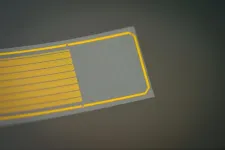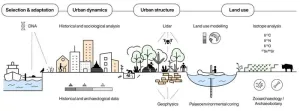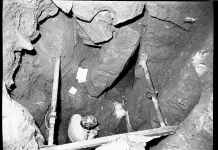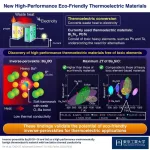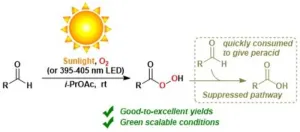(Press-News.org) PULLMAN, Wash. -- Researchers have taken the first steps toward finding liquid solvents that may someday help extract critical building materials from lunar and Martian-rock dust, an important piece in making long-term space travel possible.
Using machine learning and computational modeling, Washington State University researchers have found about half a dozen good candidates for solvents that can extract materials on the moon and Mars usable in 3D printing. The work, reported in the Journal of Physical Chemistry B, is led by Soumik Banerjee, associate professor in WSU’s School of Mechanical and Materials Engineering.
The powerful solvents, called ionic liquids, are salts that are in a liquid state.
“The machine learning work brought us down from the 20,000-foot to the 1,000-foot level,” Banerjee said. “We were able to down select a lot of ionic liquids very quickly, and then we could also scientifically understand the most important factors that determine whether a solvent is able to dissolve the material or not.”
As part of its Artemis mission, NASA, which funded Banerjee’s work, wants to send humans back to the moon and then to deeper space to Mars and beyond. But to make such long-term missions possible, astronauts will have to use the materials and resources in those extraterrestrial environments, using 3D printing to make structures, tools, or parts from essential elements extracted from lunar or Martian soil.
“In situ resource utilization is a big deal over the next couple of decades for NASA,” said Banerjee. “Otherwise, we would need a terribly high payload of materials to carry from Earth.”
Acquiring those building materials must be done in an environmentally friendly and energy efficient way. The method to mine the elements also can’t use water, which isn’t available on the moon.
Ionic liquids, which Banerjee’s group has been studying for more than a decade for use in batteries, could be the answer.
Testing each ionic liquid candidate in a lab is expensive and time consuming, however, so the researchers used machine learning and modeling at the level of atoms to narrow down from hundreds of thousands of candidates. They looked for those that might digest lunar and Martian materials, extract important elements such as aluminum, magnesium, and iron, regenerate themselves, and perhaps produce oxygen or water as a byproduct to help provide life-support.
Identifying superior qualities that the solvents will need, the researchers were able to find about half a dozen very strong candidates. Important factors for success included the size of the molecular ions that make up the salts, its surface charge density, which is the charge per unit area of the ions, and the mobility of the ions in the liquids.
Working with researchers at the University of Colorado in a separate study , the researchers tested a few ionic liquids in the lab for their ability to dissolve compounds. They hope to eventually build a lab-scale or pilot-scale reactor and test good candidate solvents with lunar regolith-type materials.
END
Potential solvents identified for building on moon and Mars
2024-01-11
ELSE PRESS RELEASES FROM THIS DATE:
Generative artificial intelligence models effectively highlight social determinants of health in doctors’ notes
2024-01-11
Where we live and work, our age, and the conditions we grew up in can influence our health and lead to disparities, but these factors can be difficult for clinicians and researchers to capture and address. A new study by investigators from Mass General Brigham demonstrates that large language models (LLMs), a type of generative artificial intelligence (AI), can be trained to automatically extract information on social determinants of health (SDoH) from clinicians’ notes which could augment efforts to identify patients who may benefit from ...
Transparent brain implant can read deep neural activity from the surface
2024-01-11
Researchers at the University of California San Diego have developed a neural implant that provides information about activity deep inside the brain while sitting on its surface. The implant is made up of a thin, transparent and flexible polymer strip that is packed with a dense array of graphene electrodes. The technology, tested in transgenic mice, brings the researchers a step closer to building a minimally invasive brain-computer interface (BCI) that provides high-resolution data about deep neural activity by using recordings from the brain surface.
The work was published on Jan. 11 in Nature Nanotechnology.
“We are expanding the spatial ...
Ancient cities provide key datasets for urban planning, policy and predictions in the Anthropocene
2024-01-11
Cities play a key role in climate change and biodiversity and are one of the most recognizable features of the Anthropocene. They also accelerate innovation and shape social networks, while perpetuating and intensifying inequalities. Today over half of all humanity lives in cities, a threshold which will rise to nearly 70% by the mid-21st century. Yet despite their importance for the Anthropocene, cities are not a recent phenomenon.
In a new study, an interdisciplinary team of authors from the Max Planck Institute of Geoanthropology ...
First prehistoric person with Turner syndrome identified from ancient DNA
2024-01-11
Francis Crick Institute press release
Under strict embargo: 10:00hrs GMT 11 January 2024
Peer reviewed
Observational study
People
First prehistoric person with Turner syndrome identified from the Iron Age
Earliest known person with Jacob’s syndrome identified from Early Medieval Period
Individuals with Klinefelter syndrome identified across a range of time periods
New technique developed to measure number of chromosomes in ancient genomes more precisely
Researchers at the Francis Crick Institute, working with University of Oxford, University of York ...
Reduced blood lead levels linked to lower blood pressure in American Indians
2024-01-11
Researchers have linked a decade-long decline in the blood lead levels of American Indian adults to long-term cardiovascular health benefits, including reduced blood pressure levels and a reduction in a marker associated with hypertrophic cardiomyopathy and heart failure. The research team, supported by the National Institutes of Health, found that adults who had the greatest reductions in blood lead levels saw their systolic blood pressure fall by about 7 mm Hg, an amount comparable to the effects of blood pressure-lowering medication. Lead exposure is known to harm the health of children by damaging the brain and nervous system and slowing growth and development. It has also been associated ...
Reduced blood lead levels linked to lower blood pressure
2024-01-11
Through the Strong Heart Family Study, National Institutes of Health-supported researchers found that small declines in blood lead levelswere associated with long-term cardiovascular health improvements in American Indian adults. Participants who had the greatest reductions in blood lead levels saw their systolic blood pressure fall by about 7 mm Hg, an amount comparable to the effects of blood pressure-lowering medication.
The findings as reported from researchers at Columbia ...
Ocean temperatures helped make 2023 the hottest year ever recorded
2024-01-11
A multi-national team of scientists (China, USA, New Zealand, Italy, and France) analyze the temperature of the Earth annually. These scientists have found a fever that increases every year. For the past decade, each year has been hotter than the prior year in the ocean. And there are other changes in the ocean that also matter.
The ocean is an important part of the Earth's climate system – it covers 70% of the planet and absorbs about 90% of the heat from global warming. The ocean helps control the atmosphere – a warmer ocean leads to a warmer and moister atmosphere with wilder weather. The ocean also controls ...
Towards realizing eco-friendly and high-performance thermoelectric materials
2024-01-11
In a new study, environmentally benign inverse-perovskites with high energy conversion efficiency have been reported by Tokyo Tech scientists with potential for practical application as thermoelectric materials (TEMs). Addressing the limitations typically faced with TEMs, such as insufficient energy conversion efficiency and environmental toxicity due to heavy elements, the new TEMs provide a suitable alternative to TEMs based on toxic elements with better thermoelectric properties than conventional eco-friendly TEMs.
Thermoelectric materials (TEMs) capable of converting thermal energy to electrical energy and vice versa have become an essential part of our world, which needs ...
Watching others visibly dislike vegetables might make onlookers dislike them, too
2024-01-11
Humans learn which behaviors pay off and which don’t from watching others. Based on this, we may draw conclusions about how to act – or eat. In the case of the latter, people may use each other as guides to determine what and how much to eat. This is called social modelling and is one of the most powerful social influences on eating behavior.
In a new study, researchers in the UK investigated whether observing others’ facial expressions while eating raw broccoli influenced young women’s liking and desire to ...
Making an important industrial synthesis more environmentally friendly
2024-01-11
Osaka, Japan – Approximately 5% of global carbon emissions are attributable to producing the chemicals that are essential to modern life. Creating a sustainable solution to one chemical reaction in particular – the autoxidation of aldehydes – has challenged researchers for decades.
Now, in a study recently published in Green Chemistry, researchers from Osaka University, Shizuoka Institute of Science & Technology, and collaborating partners have solved this problem. Through reaction kinetics and mathematical ...

